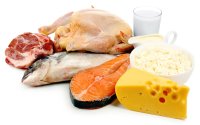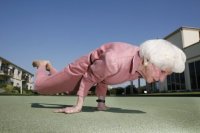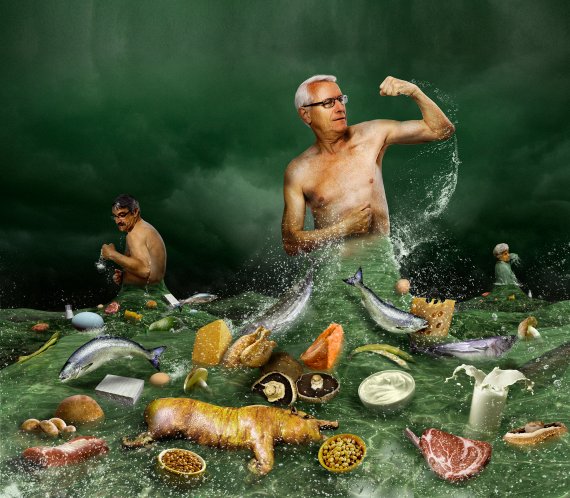Text: Joost Visser, illustration: Pascal Tieman
‘A candle isn’t dimmed when you use it to light another candle,’ said the 13th century philosopher and mystic Mevlana. And this is the motto of the thesis for which Canan Ziylan received her PhD at Wageningen University on 9 December. ‘You don’t lose anything by helping other people to make progress,’ says the young doctor about his choice of text. ‘And a lot of people worked selflessly on this thesis too.’ You could apply the same idea to the topic of Ziylan’s study too: the significance of protein-rich meals for vulnerable seniors. His study is one of a broad range of studies at WUR, all aimed at preventing seniors from losing muscle mass and strength too fast, at the expense of their physical performance.
Vulnerable seniors
It was Michael Tieland who showed in his Wageningen PhD study ProMuscle (2013) that the combination of protein supplementation and strength training could combat this loss of muscle mass and strength – known as sarcopenia. In one of his intervention studies over 60 vulnerable seniors followed a strength training programme for six months. Half of them were given a supplement of 15 grams of protein a day; the other half were given a placebo. The muscle power of both groups grew by 40 percent in those 24 weeks. However, the muscle mass of the control group hardly changed, while that of those who had received protein as well had increased by an average of 1.3 kilos. Conclusion: long-term strength training is an effective way of improving the physical performance of fragile seniors, but extra protein consumption is necessary to actually increase their muscle mass.
So there is room for improvement among seniors who are not active and whose protein intake is not optimal
‘So there is room for improvement among seniors who are not active and whose protein intake is not optimal,’ says Lisette de Groot, professor of Nutrition of the elderly, and one of Tieland’s supervisors. ‘It is not true that it no longer makes any difference once people are old.’ Her own research is focused on all four determinant of the performance of elderly people: cognitive decline (which can lead to dementia), osteoporosis (reduced bone mass), anorexia of aging (disturbed appetite regulation) and sarcopenia. With reference to the latter, she notes that muscle mass is active tissue. The ‘turnover’ – the incorporation and release of proteins – is quite rapid. ‘A senior who is bedridden, for instance, loses muscle mass quickly. If that happens frequently, the decline is progressive. Strength training can slow that process, in combination with adequate protein intake.’
Meal delivery service
 It has repeatedly been demonstrated that this is the best combination, agrees Ziylan, whose research was also supervised by De Groot: ‘But that was always in the context of academic research, with motivated participants. The question is how you can reach seniors living at home who don’t look after themselves properly and are much less motivated.’ For one of the four studies in her thesis, she interviewed over 300 vulnerable seniors, all of them dependent on a meal delivery service. A little over one fifth (22 percent)
It has repeatedly been demonstrated that this is the best combination, agrees Ziylan, whose research was also supervised by De Groot: ‘But that was always in the context of academic research, with motivated participants. The question is how you can reach seniors living at home who don’t look after themselves properly and are much less motivated.’ For one of the four studies in her thesis, she interviewed over 300 vulnerable seniors, all of them dependent on a meal delivery service. A little over one fifth (22 percent)
of them turned out to be undernourished, and another seven percent were at risk of becoming so. Why is that? The meals – on average 45 grams – turned out to be too big for most of the customers, and they also suffered from a loss of appetite. Ziylan: ‘The older you get, the fewer signals you get that you are hungry or thirsty. People’s appetites also diminish because they get less exercise. And for some of them food stops tasting good, sometimes because of the medicines they take.’
The solution was obvious: small meals with extra protein. For a laboratory study involving 120 seniors living at home, Ziylan and a ready meals producer developed a few popular meals (such as chicken with spinach and mashed potato), each in four variants. There were large (450 gram) and small (400 gram) portions, with normal (25 gram) and extra-large (30 gram) servings of protein. It took a while to find the right formula. ‘At first we used protein powder, but when you heat that up in a microwave the puree changes into something resembling wallpaper paste. The only way to make it work was with milk powder and extra milk or water.’ Regardless of the size of the meal, the test subjects (who didn’t know anything about the four variants) – always ate 85 percent of the meal. So without realizing it, those who got a large, protein-rich meal ate the most protein. A disadvantage was that these people had a satiated feeling for longer than the others. They might therefore compensate by eating less at the next meal, or by skipping a snack, which would cancel out the effect of the extra protein.
Dietician

This led to a last, double-blind study in which 42 seniors living at home were served one of 16 meals every day for two weeks. The meals were all the same size but 8 were normal and 8 protein-rich. The meals went down well, whether they were enriched or not. Nor did the enriched meals lead to the feared ‘compensation’, as an analysis of diaries handed out beforehand revealed. All in all, people who had had the protein-rich meals had consumed 87.7 grams of protein per day, including the protein-rich bread served for breakfast and lunch. The others stayed at 73.1 grams, a difference of 14.6 grams. ‘It is important to pick up a protein deficiency in seniors early,’ concludes Zijlan. ‘By asking them to write down what they eat for a few days, for instance. A carer can then see what goes wrong, and can refer seniors to a dietician in good time. That doesn’t happen often enough at present.’
It is important to pick up a protein deficiency in seniors early
Ziylan’s findings are in line with those of Janne Beelen, who got her PhD two months previously for a similar study. In the Cater with Care project, which WUR is involved in, she studied the effect of specially developed protein-rich foods such as bread, juice and soup on the protein intake and physical performance of seniors. While they were inpatients at the Gelderse Vallei hospital, 147 seniors were on a menu including such products. Of the intervention group, 79 percent achieved the target of 1.2 grams per kilo of bodyweight per day, as opposed to 48 percent of the control group. Half of the participants wanted to carry on with the study at home. In the 12 weeks of the follow-up study, 72 percent achieved the target as opposed to 31 percent of the control group.
Four days
Extra protein combined with strength training is not just effective for vulnerable seniors; it can also be useful for patients who get less exercise than desirable in their daily lives, and who are due to undergo an operation soon. ‘From a physiological point of view, a major operation lasting a couple of hours is the equivalent of strenuous sport,’ says Maria Hopman, professor of Integrative Physiology at the academic hospital Radboud UMC and ‘figurehead’ at the innovation centre Eat2Move. She supervises PhD research intended to establish whether protein and exercise will help patients of 50 to 70 years of age cope better with – in this case – a bowel operation. A randomized controlled trial is planned for next year in the Gelderse Vallei hospital. The prospects are promising: preliminary studies showed that in just two to four weeks the muscle power of inactive seniors can be boosted considerably with the help of protein and exercise.
Hopman, who works in Wageningen one day a week, is best known for her study of walkers in the four-day walking event the ‘Nijmeegse Vierdaagse’. For next year she has plans for a study of the effect of extra protein on the muscle mass and strength of the countless fit 60-somethings who take part in the walk and of whom it is known from surveys that they consumer less than 1.0 grams of protein per kilo per day. About 120 walkers will be taking part in the study, half of whom will be given a daily protein drink and the other half a placebo. They have to drink the mixture at breakfast (usually the least protein-rich meal of the day)
, straight after their daily walk. Hopman: ‘We will start in April and carry on until the four-day event itself. On those days we will monitor whether the walkers who had the extra protein get less muscular pain and recover faster, as we expect.’
In practice
Back to ProMuscle, Michael Tieland’s pioneering study. It was done in a controlled setting: the participants came to the university and received their training and protein drink, as well as guidance from the researcher. The approach is different in the follow-up project, ProMuscle in Practice, which started last month. Until the autumn of 2018, about 200 vulnerable seniors of 65 and older will take part in the project, half of them in an intervention group and the other half in a control group. They will be divided into five groups started in succession, in five municipalities in the Veluwe area. After a baseline measurement, the members of the control group will carry on as usual until the final measurement 24 weeks later. Meanwhile, their counterparts in the intervention group will first get 12 weeks of strength training from physiotherapists at a health centre in their municipality. After that they will proceed as an ‘exercise group’ to the local sports club for another 12 weeks of training – in the hope that they will then continue with this later on their own initiative.

‘The focus of the training is on the leg muscles,’ explains Nick Wezenbeek, one of the two PhD researchers working on the ProMuscle studies. ‘People push against a surface with their legs, or push a weight upwards. Depending on their strength, one might start with 40 kilos and another with 100 – but for all of them the weight is gradually increased a little bit every time.’
Our main aim is to increase the amount of protein eaten at breakfast and lunch
Besides these trainings, the participants get personal nutritional advice from a dietician. The aim is for every participant to be consuming at least 25 grams of protein per main meal: breakfast, lunch and dinner. Wezenbeek: ‘Our main aim is to increase the amount of protein eaten at breakfast and lunch. Not by giving them a protein drink but with standard products you can buy at the supermarket. That way it is easier for people to change their habits.’
Behavioural change
After 24 weeks the researchers will see whether the participants in the intervention group really have made progress, compared with the others. ‘In this measurement we look especially at physical performance,’ says Wezenbeek. ‘What is these people’s walking speed? How fast can they get up out of a chair? What is their balance like? We also look at muscle strength and at muscle mass and bone density, using a Dexa scanner.’ The participants’ healthcare costs are scrutinized as well: is there a difference between the two groups in terms of visits to the doctor and the physiotherapist? Or in terms of their need for home-based care and rehabilitation? Wezenbeek: ‘We reveal not just what the programme costs, but what it saves. If the balance is positive, it could perhaps be implemented elsewhere as well.’
The research on the effect of protein and exercise on the performance of seniors has clearly developed since it started in the laboratory. Now it takes place mainly in the context of everyday life, and the seniors involved are no longer passive test subjects but active participants. Which brings behavioural change a step closer – and that was precisely the idea.

